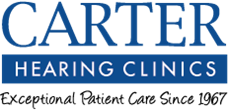To determine your hearing sensitivity, we conduct a diagnostic hearing evaluation. We begin with a Threshold Audiogram. Generally, narrow-band noise or pure-tones are used to determine the softest level you can detect in each ear at various frequencies or pitches.
Word recognition testing and other special tests may also be conducted to further evaluate the adequacy of the auditory system. This information is used to help determine the type of hearing impairment, the possible location of the impairment, and the necessary means of treatment and/or rehabilitation.
In some cases, the test results and/or particular symptoms will warrant further evaluation of the auditory and/or vestibular system prior to the beginning of the rehabilitation process.
Binaural amplification is recommended for bilateral hearing loss to reduce the detrimental effects of auditory deprivation. It will also provide better sound localization, help improve your ability to understand speech in noisy environments, and help to process overall sound more efficiently.
Several styles of hearing aids and levels of technology are available to improve hearing. The styles include: In-the-Ear (ITE); Behind-the-Ear (BTE); Behind-the-Ear Open (BTE Open); Receiver-in-Canal (RIC); Completely-in-the-Canal (CIC); and Invisible-in-Canal (IIC). The type or style of instrument is generally based on the hearing evaluation, the anatomy of the external ear, the life-style of the individual, age, etc.
The data from the Threshold Hearing Evaluation is used to help determine the appropriate prescription. A formula is calculated that determines the amount of amplification required at each frequency or pitch. An individualized circuit or computer chip is assembled based on these specifications. Additional supra-threshold data may be utilized to more accurately calculate loudness sensitivity. These defined loudness parameters are used in digitally programming the hearing instruments for a particular individual’s needs.
This sophisticated technology incorporates digital signal processing. Advanced circuits may include adaptive compression, variable release compression, wide-range active filters, and other noise suppression type features. Some circuits may also utilize directional microphones to further enhance understanding speech in the presence of background noise. A user volume control may not be necessary due to the automatic functioning of these devices. Most circuits contain multiple memory options for different listening environments. They may also include feedback cancellation systems and remote control technology as well as Bluetooth capability in relation to cell phones and other accessories.
As soon as the hearing aid selection process is completed and your instruments are manufactured and fitted, you will be instructed on the use and care of your hearing aids.
It is recommended that during the trial period, you wear your hearing aids daily in order to facilitate the adaptation process. Not only will you need to adapt to using the aids, but your ears will be adapting physiologically as well.
At first, your ears may be sensitive to the amplified sound, but after several weeks, this sensitivity generally subsides. The adjustment period varies from person to person, but most people adapt within three to four weeks. The trial period may be extended beyond 60 days when necessary.
You are strongly encouraged to report your experiences with the new hearing aids to our audiologists so we know how best to "fine-tune" the instruments for optimum results.
Ultimately, the goal of our treatment program is to significantly reduce the handicapping effect of the hearing impairment by providing you the opportunity to experience the latest in hearing aid technology while receiving appropriate counseling and auditory training from our Audiology staff.
The Extended Warranty Program is offered to protect your hearing aids against loss, theft, fire, accidental damage, and much more.
You can apply for this coverage at any time. Your hearing aids simply need to be inspected to determine appropriate functioning before coverage can take place or when renewing your coverage.
Your coverage will continue after your instrument is repaired, up until the expiration of the coverage period. Your coverage ends if your hearing aid needs to be replaced. Your coverage can be renewed, however, at any time, once your hearing aids have been inspected. You may also apply for coverage on the repair of hearing aids.
There is a deductible of $250 on the replacement digital hearing aids. There is NO deductible for repaired hearing aids.
The program also applies 50% of all premiums that you pay toward your personal hearing aid credit account to be used as a discount on future hearing aid purchases. (Deductibles on replaced hearing aids do not apply. There is a $1000 maximum credit toward new hearing aids)
Carter Hearing Clinics offers a Battery Program that will apply 100% of all the money you spend on batteries at our office to your personal hearing aid credit account to be used as a discount on future hearing aid purchases. We not only have the best prices on hearing aid batteries, but we will also mail the batteries to you at your convenience.
